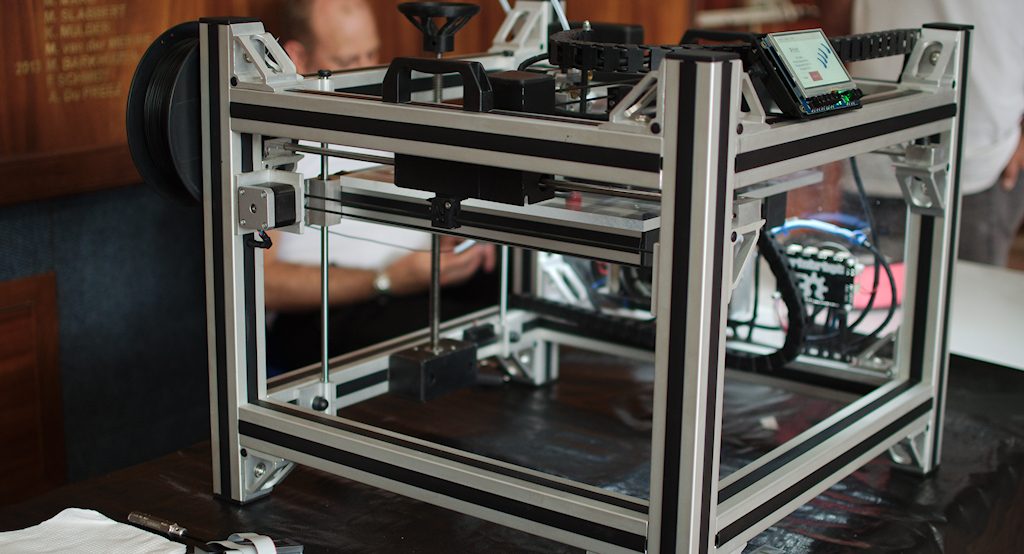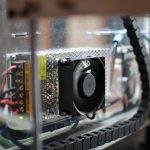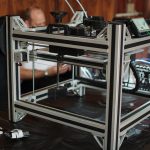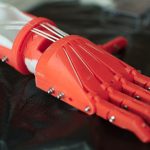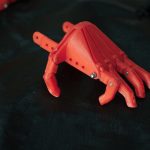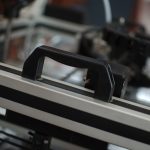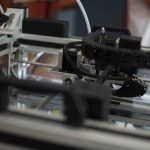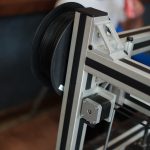“I used to describe myself as ‘just a South African guy with an idea’,” says Richard van As, modestly, “Now I guess you could call me ‘just a South African guy with another idea’.”
But what an idea it is. To design and build the world’s toughest, roughest low-cost 3D printer and unleash it upon the world to do good.
Once upon a time – say, oh, yesterday – 3D printers were fey things which would collapse under the pressure of a hard stare. Mechanically sensitive to the slightest knock and happy to overheat under the gaze of a warm bulb, common or garden 3D printers for home or light industrial use are best built in one very stable position and left there lest they require many hours of tinkering to produce useable prints again.
Not any more: enter RoboBeast, the Chuck Norris of printers which was unveiled to the general public today.
RoboBeast is designed to be ‘bulletproof’. It requires no set-up software tweaks, or mechanical adjustment of the frame before you print. It’s designed to be thrown in the back of a Land Rover, carted off into the bush, and to start working as soon as the power is on. You can move it during operation and the print head stays steady: it can even print if flipped upside down.
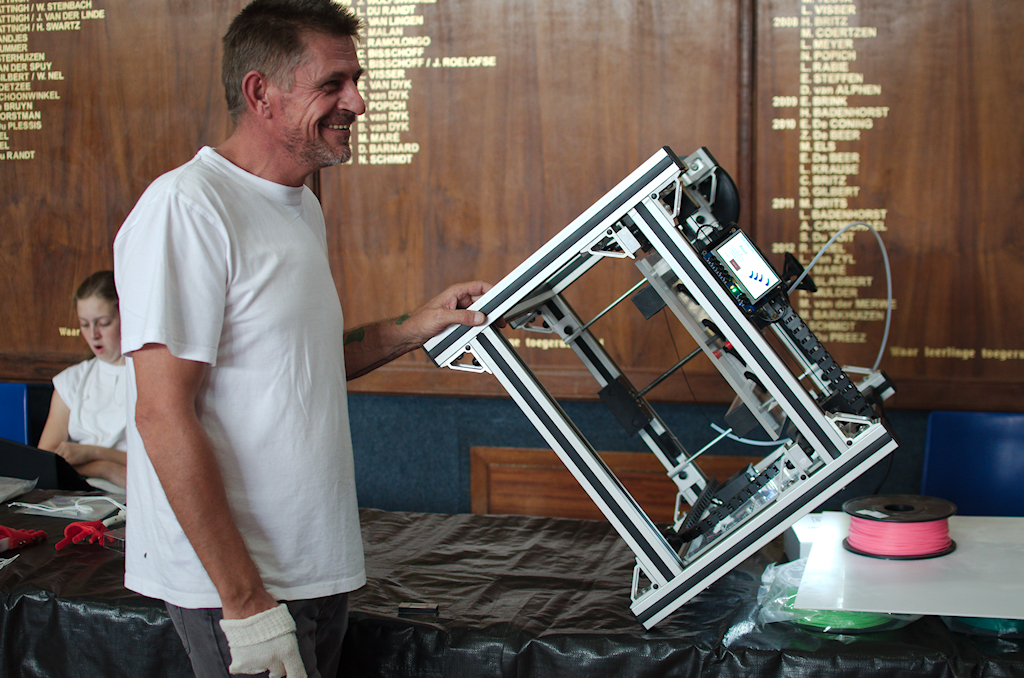
And yet at heart, it shares exactly the same DNA as the RepRap open hardware design that underpins every ‘affordable’ 3D printer commercially available or (relatively) easy to build at home. It’s an open source design – you can build one yourself if you like – and it’s been created specifically to help amputees in worn-torn and inaccessible areas of the world.
If that all that wasn’t enough to make you fall in love with RoboBeast, it gets better. The first RoboBeast has been designed and built in a two and a half month period which includes the Christmas break. And its inventor, van As, is the carpenter who shot to fame almost a year ago following a Popular Mechanics South Africa article about RoboHand.
‘Designer Digits‘ was the story of how vas As lost four fingers on his right hand in an accident at work, and how through an online collaboration with US inventor Ivan Owen he developed not just a DIY prosthetic for himself, but the pair went on to create a one for a five-year-old boy named Liam too. By adapting the design so that it could be customised and built by anyone with access to a RepRap-style 3D printer, RoboHand was born.
The story went truly viral. Van As explains that he’s been interviewed countless times by hundreds of journalists about RoboHand, and has been invited all over the world to tell the story and work on more collaborations. He receives hundreds of mails a day about RoboHand, and has been kicked off of his webhost because of the volume of traffic.
At CES this year, a second chapter was added to the RoboHand story thanks to Project Daniel – through which US inventor Mick Ebeling took Makerbot printers to Sudan in order to build prosthetics for some of the thousands of children injured in the civil war there. Although van As didn’t accompany Ebeling to Sudan, he was involved in the project.
Again, the story was picked up by almost every major news organisation in the world.
Keeping up with RoboHand has been demanding work. Even with the whole-hearted support of family and friends, it’s been a long time since van As was able to take on a carpentry job.
“I’m basically unemployed now,” he laughs, “This is what I do now.”
Towards the end of last year, van As moved the RoboHand project into House4Hack, the Centurion makerspace which is run by volunteers and has been home to other world-class 3D printing inventions. The award winning RepRap Morgan was designed there, and South Africa’s leading 3D print and open source hardware specialist community and shop, Open Hardware, came out of the House4Hack community too.
The original plan was to create a ‘botfarm’ of 3D printers in a backroom at House4Hack which would be capable of producing printed RoboHands en masse for people who can’t afford medical prosthetics.
“We work on a ‘pay it forward’ system,” says van As, “Amputees contact us asking for help and where we can, we send them a RoboHand. Then, if they’re able to work where they weren’t before, they can consider a donation to help us keep going.”
Van As says that the finnicky nature of current 3D printer designs is frustrating though. After the experience with Project Daniel the need for a printer which just works, and will continue to work no matter what, became pressing.
Enter RoboBeast. With the help of other House4Hack members, a prototype of the super-tough printer has been put together in just two and a half months from design to full operation, and van As says four more are currently being built. Final dimensions haven’t been decided on, but the build will be considerably bigger than the 200x200x200mm cube that most RepRap-type printers are capable of.
The electronics which drive the printer are all off-the-shelf components. The controller is an Arduino motherboard with a standard RAMPS add-on ‘shield’ for driving the motors, as well as a touchscreen LCD panel and SD card reader.
Where RoboBeast differs from most open hardware printers, though, is that there are very few printed parts inside. A core ethos of RepRap culture is to create machines that can reproduce most of their working parts themselves: the name itself is a contraction of ‘self-REPlicating RAPid prototyper’.
For RoboBeast, however, van As has used mostly cut-to-order aluminium struts and a custom milled extruder. The result is something far more durable and robust. Using software tweaks inherited from Quentin Harley’s RepRap Morgan, RoboBeast’s extruder head will also be able able to calibrate itself to compensate for any movement in the print bed, ensuring evenly layered prints regardless of whether or not the machine is level.
To make it easy to operate, RoboBeast’s SD card is loaded with preconfigured RoboHand models in a variety of sizes. Recipients just need to tap the correct size on the touchscreen and wait while the hotend – which melts the plastic filament and squirts it out in fine layers – does its finger-making dance around the build surface and builds a working RoboHand. The SD card is more or less inaccessible, trapped behind the perspex of the vent which covers the controller board. Other models can be set-up using the USB port.
For the final touch in self-sufficiency, van As plans to couple RoboBeast with a battery that will power the machine for up to five hours on a single charge. Co-incidentally, that’s almost exactly how long it takes to produce an adult RoboHand.
Naturally, this design is more expensive than building a ‘traditional’ 3D printer, but it’s not prohibitively so: van As reckons the total bill of materials will be around R27 000 ($2 500) per machine: considering an off-the-shelf MakerBot 2 costs $2 100, that’s not terrible value.
Now that RoboBeast has been unleashed up on the world, it even has its own website and Facebook page already, van As is planning to eventually build models to sell. It’s first big test, however, will come in a few months time when he’s planning an excursion to take RoboHand to places its never been and sorely needed. Where exactly that will be, however, he won’t tell. Yet.
Watch this space.
[Want more? RoboBeast website and Facebook page]

